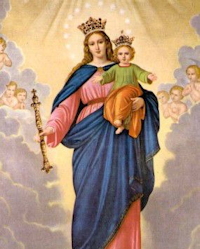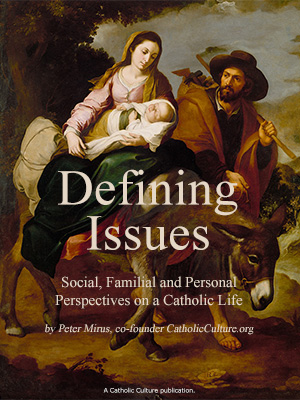Make your gift today!
Help keep Catholics around the world educated and informed.
Already donated? Log in to stop seeing these donation pop-ups.
Ordinary Time: May 24th
Memorial of the Blessed Virgin Mary, Mother of Church; Australia: Solemnity of Mary Help of Christians; Bl. Louis-Zepherin Moreau (Canada)
Other Commemorations: Mary Help of Christians (Solemnity, Australia); Bl. Louis-Zepherin Moreau, Bishop (RM; Opt Mem, CAN)
» Enjoy our Liturgical Seasons series of e-books!
St. Paul VI, at the conclusion of the Third Session of the Second Vatican Council in 1964, declared the Blessed Virgin Mary as “Mother of the Church," that is to say of all Christian people, the faithful as well as the pastors, who call her the most loving Mother and established that “the Mother of God should be further honored and invoked by the entire Christian people by this tenderest of titles”. But it was not until February 11, 2018, that the Congregation for Divine Worship and the Discipline of the Sacraments inscribed a new obligatory Memorial of the Blessed Virgin Mary as Mother of the Church, into the General Roman Calendar. This memorial is celebrated every year on the Monday after Pentecost, which is appropriate as Mary was also present in that room for the birthday of the Church.
The liturgical celebration, B. Mariæ Virginis, Ecclesiæ Matris, will be celebrated annually as a Memorial on the day after Pentecost.
Today the Church in Australia celebrates the Solemnity of Mary Help of Christians. Mary Help of Christians was adopted as patron of the new Church of Australia in 1844, at a significant time in their history. British settlement was just over fifty years old, the transportation of convicts was coming to an end, and the first elections in Australian history had been held in 1843. Issues of land, immigration and education had begun to surface and the Church was involved in these social problems. The Holy See confirmed the patronage in 1852.
The Canadian Church honors Bl. Louis-Zephirin Moreau today. He is the founder of the communities of the Sisters of Saint Joseph and the Sisters of Sainte Marthe. He also participated in the founding of numerous other institutions and pious works. He died on May 24, 1901.
Mary, Mother of the Church
By issuing the Decree on the celebration of the feast of Mary, Mother of the Church, Pope Francis wishes to promote this devotion in order to “encourage the growth of the maternal sense of the Church in the pastors, religious and faithful, as well as a growth of genuine Marian piety”.
The decree reflects on the history of Marian theology in the Church’s liturgical tradition and the writings of the Church Fathers.
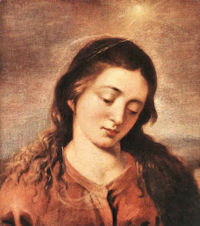 It says Saint Augustine and Pope Saint Leo the Great both reflected on the Virgin Mary’s importance in the mystery of Christ.
It says Saint Augustine and Pope Saint Leo the Great both reflected on the Virgin Mary’s importance in the mystery of Christ.
“In fact the former [St. Augustine] says that Mary is the mother of the members of Christ, because with charity she cooperated in the rebirth of the faithful into the Church, while the latter [St. Leo the Great] says that the birth of the Head is also the birth of the body, thus indicating that Mary is at once Mother of Christ, the Son of God, and mother of the members of his Mystical Body, which is the Church.”
The decree says these reflections are a result of the “divine motherhood of Mary and from her intimate union in the work of the Redeemer."
Scripture, the decree says, depicts Mary at the foot of the Cross (cf. Jn 19:25). There she became the Mother of the Church when she “accepted her Son’s testament of love and welcomed all people in the person of the beloved disciple as sons and daughters to be reborn unto life eternal.”
In 1964, the decree says, Pope Paul VI “declared the Blessed Virgin Mary as ‘Mother of the Church, that is to say of all Christian people, the faithful as well as the pastors, who call her the most loving Mother’ and established that 'the Mother of God should be further honoured and invoked by the entire Christian people by this tenderest of titles.’”
Things to Do:
Mary Help of Christians
As Mother of God's children, Mary has responded by helping Christians throughout the ages. She has done this by coming to the aid of individuals, families, towns, kingdoms and nations.
In 1214 she gave the Rosary to Saint Dominic as a weapon to combat the Albigesian heresy which was devastating Southern France. It is very clear to Christians and it is also the Will of God that we have and will continue to have the Help of Mary through the recitation of the Holy Rosary.
In the year 1531 Our Lady appeared in Mexico to an indian named Juan Diego. He was a humble peasant aged 51. As a result of the apparitions, over 10 million indians were converted to Catholicism, the sacrificial killings of babies stopped, and Our Lady left an image which is a reflection of herself imprinted miraculously on the tilma of Juan Diego.
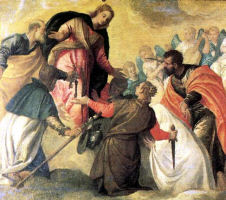 In 1571 the whole of Christendom was saved by Mary Help of Christians when faithful Catholics throughout Europe prayed the Rosary. The great battle of Lepanto occurred on October 7th 1571. For this reason this date has been chosen as the feast of the Holy Rosary. In 1573 Pope Pius V instituted the feast in thanksgiving for the decisive victory of Christianity over Islamism.
In 1571 the whole of Christendom was saved by Mary Help of Christians when faithful Catholics throughout Europe prayed the Rosary. The great battle of Lepanto occurred on October 7th 1571. For this reason this date has been chosen as the feast of the Holy Rosary. In 1573 Pope Pius V instituted the feast in thanksgiving for the decisive victory of Christianity over Islamism.
Near the end of the 17th century, Emperor Leopold I of Austria took refuge in the Shrine of Mary Help of Christians at Pasau, when 200,000 Ottoman Turks besieged the capital city of Vienna. Pope Innocent XI united Christendom against the ominous attack of Mohammedanism. A great victory occurred thanks to Mary Help of Christians. On September 8th, Feast of Our Lady's Birthday, plans were drawn for the battle. On September 12, Feast of the Holy Name of Mary, Vienna was finally freed through the intercession of Mary Help of Christians. All Europe had joined with the Emperor crying out "Mary, Help!" and praying the Holy rosary.
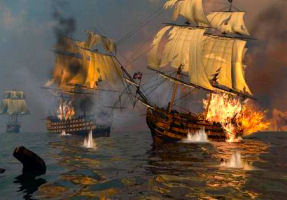 In 1809, Napoleon's men entered the Vatican, arrested Pius VII and brought him in chains to Grenoble, and eventually Fontainbleau. His imprisonment lasted five years. The Pope smuggled out orders from prison for the whole of Christendom to pray to Our Lady Help of Christians, and thus the whole of Europe once again became a spiritual battle ground, not of arms against ruthless arms, but of Rosaries against ruthless military might. Soon Napoleon was off the throne and the Pope freed from prison.
In 1809, Napoleon's men entered the Vatican, arrested Pius VII and brought him in chains to Grenoble, and eventually Fontainbleau. His imprisonment lasted five years. The Pope smuggled out orders from prison for the whole of Christendom to pray to Our Lady Help of Christians, and thus the whole of Europe once again became a spiritual battle ground, not of arms against ruthless arms, but of Rosaries against ruthless military might. Soon Napoleon was off the throne and the Pope freed from prison.
After proving her maternal help, throughout the centuries, Our Lady has continued to appear in hundreds of places throughout the world mainly during the 20th century, Lourdes and Fatima being the most famous apparitions. She has brought help from Heaven, and has warned her children to do prayer and penance as a formula for peace. She has stressed that her children must pray the Holy Rosary daily.
—Taken from The Work of God website.
Patronage: Church in Australia; Andorran security forces; Austrailian military chaplains; New York; New Zealand
Highlights and Things to Do:
- Make a virtual visit to the Basilica of Our Lady, Help of Christians in Hubertus, Wisconsin.
- Read more about Our Lady Help of Christians:
- Travel via the Internet to the Shrine of Mary Help of Christians built by St. John Bosco as a monument to the Virgin Mary, with the title Help of Christians, as the mother church and spiritual center of the Salesian Congregation.
Bl. Louis-Zepherin Moreau
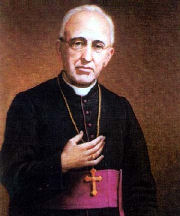 Born and baptised at Becanour on the first of April 1824, the future saint was the fifth of thirteen children from the marriage Louis-Zephirin Moreau and Marquerite Champoux-Saint-Pair. This "intelligent, pious, modest, gentle, and thoughtful" child was educated in his native parish until the age of fifteen before being admitted into the Seminary of Nicolet. In 1844, he received the ecclesiastic habit at Quebec, but in 1845, Msgr. Signay sent him back home, because he found him to be in fragile health. It would take more than this setback to discourage the young man on his path towards the priesthood. He then begged Msgr. Bourget to permit him to achieve his dream at the Ecole de theology of Montreal. This was accomplished, thanks to the kindness of Msgr. Prince, head of this institution. Father Moreau was ordained a priest on December 19, 1846 at the age of 22. Six years later, Msgr. Prince became the first titular of the new diocese of Saint-Hyacinthe and he appointed Father Moreau as secretary-chancellor. The apprenticeship of the future prelate was as parish priest for the cathedral, and he was administrator of the diocese five times. On January 15, 1876, at the age of 51, Father Moreau became the fourth bishop of Saint Hyacinth.
Born and baptised at Becanour on the first of April 1824, the future saint was the fifth of thirteen children from the marriage Louis-Zephirin Moreau and Marquerite Champoux-Saint-Pair. This "intelligent, pious, modest, gentle, and thoughtful" child was educated in his native parish until the age of fifteen before being admitted into the Seminary of Nicolet. In 1844, he received the ecclesiastic habit at Quebec, but in 1845, Msgr. Signay sent him back home, because he found him to be in fragile health. It would take more than this setback to discourage the young man on his path towards the priesthood. He then begged Msgr. Bourget to permit him to achieve his dream at the Ecole de theology of Montreal. This was accomplished, thanks to the kindness of Msgr. Prince, head of this institution. Father Moreau was ordained a priest on December 19, 1846 at the age of 22. Six years later, Msgr. Prince became the first titular of the new diocese of Saint-Hyacinthe and he appointed Father Moreau as secretary-chancellor. The apprenticeship of the future prelate was as parish priest for the cathedral, and he was administrator of the diocese five times. On January 15, 1876, at the age of 51, Father Moreau became the fourth bishop of Saint Hyacinth.
As bishop, he remained what he had always been: "good, simple, humble, and poor." Twenty three years after his death, steps were taken towards his beatification and canonization. The numerous healings which were attributed to him would later launch this irrevocable progression towards the formal recognition of his holiness.
—Excerpted from Our French-Canadian Ancestors, Thomas J. Laforest
Patronage: diocese of Saint-Hyacinthe, Québec
Highlights and Things To Do:
- Read more about Blessed Louis-Zepherin:
- He is buried in the Cathedral of Saint-Hyacinthe-le-Confesseur, Saint Hyacinthe, Québec, Canada.


